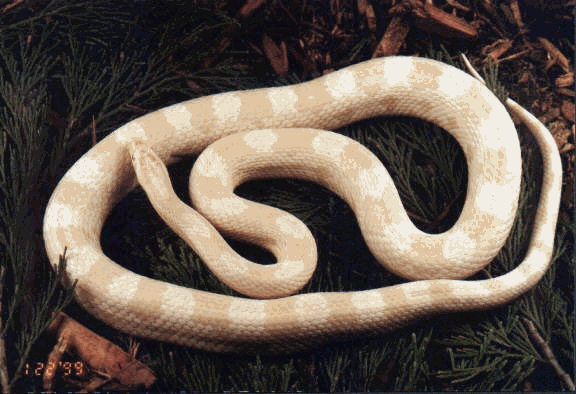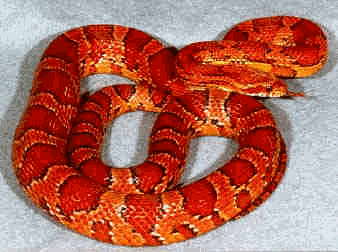|
Care of your
Corn Snake

Hatchlings- The hatchlings
of Corn (or Red Rat) snakes are
generally hardy and easy to care
for. They do require a diet of
appropriately sized rodents (in
this case, pinkie or newborn
mice). The right size food item is
often a little larger than the
snakes own head and the snakes
ability to disengage its jawbones
and stretch around the prey item
allows the snake to accomplish an
amazing eating feat. A vitamin and
mineral supplement can be added to
the prey item just prior to
feeding, but some snakes
(particularly young ones) will
refuse the prey if it smells
unfamiliar. Dusting only the rear
end of the mouse and not the head
may be acceptable to many snakes.
Hatchlings may be fed twice a week
for the first few months to get
good body weight on them initially, but
then cut back to once per week. I
recommend keeping a small water
bowl available at all times for
baby snakes, just be sure to clean
it regularly.
Adults- The adults are
maintained in much the same way.
Using larger prey items, feedings
can be scaled back to every 7 to
10 days throughout the warmer
months of the year. They donít
need vitamin supplementation quite
as often either, maybe with every
other to every third feeding. I
often supply water to adult snakes
once or twice a week and then
remove the water bowl as they tend
to spill the water or defecate in
it.
 General-
The Corn Snake comes from the
southeastern regions of United
States, ranging from Florida to
southern Maryland and west to the
Mississippi. They are largely a
diurnal snake, most active at dusk
and dawn, with a period of rest in
the daytime hours to avoid the
heat of the day. A 10-gallon tank
will comfortably house a baby to
juvenile snake, but an adult will
need more space. At least a
30-gallon tank, or caging with
similar space to it is more
appropriate for an adult snake. In
general, the snake should be able
to fully stretch out along the
longest side of the tank. A
plastic shoe or sweater box for
the hatchlings or juveniles is
acceptable and is easy to keep
sanitary. Paper towels or
newspaper make cleaning quick and
easy and eliminates the
possibility of ingesting any
substrate. We use and recommend a
shredded aspen bedding for babies
and adults alike, as it is
absorbent, easy to spot clean,
relatively cost effective, and the
snakes may burrow into it to feel
more secure. Adding some rocks,
branches, and small plants (live
or plastic) will make an
interesting landscape for your
snake to explore and add something
for the snake to rub against when
it has outgrown its skin and needs
to shed. Providing an area where
they can hide, such as a rock
shelter or hide-box is essential
and this should be placed on the
cool end of the tank. Keep a heat
pad, or thermostat controlled heat
rock available at all times on the
warm end of the tank. Proper
heating is essential to digestion
and the snake should have access
to an area that is in the range of
85 to 90 degrees. Lighting is a
matter of personal choice and
doesnít need to be too fancy
since the snakes donít seem to
care, just be sure your snake
always has access to shelter from
the light and heat if they so
choose. Put the lights on a timer
to give the snake a sense of a day
time and a night time, 12 hours on
and 12 hours off. Lastly, make
certain the cage you keep your
snake in has a tight fitting,
escape proof cover. Use cage cover
clips if you have a screen cover.
Any means of escape will be
discovered by the snake. General-
The Corn Snake comes from the
southeastern regions of United
States, ranging from Florida to
southern Maryland and west to the
Mississippi. They are largely a
diurnal snake, most active at dusk
and dawn, with a period of rest in
the daytime hours to avoid the
heat of the day. A 10-gallon tank
will comfortably house a baby to
juvenile snake, but an adult will
need more space. At least a
30-gallon tank, or caging with
similar space to it is more
appropriate for an adult snake. In
general, the snake should be able
to fully stretch out along the
longest side of the tank. A
plastic shoe or sweater box for
the hatchlings or juveniles is
acceptable and is easy to keep
sanitary. Paper towels or
newspaper make cleaning quick and
easy and eliminates the
possibility of ingesting any
substrate. We use and recommend a
shredded aspen bedding for babies
and adults alike, as it is
absorbent, easy to spot clean,
relatively cost effective, and the
snakes may burrow into it to feel
more secure. Adding some rocks,
branches, and small plants (live
or plastic) will make an
interesting landscape for your
snake to explore and add something
for the snake to rub against when
it has outgrown its skin and needs
to shed. Providing an area where
they can hide, such as a rock
shelter or hide-box is essential
and this should be placed on the
cool end of the tank. Keep a heat
pad, or thermostat controlled heat
rock available at all times on the
warm end of the tank. Proper
heating is essential to digestion
and the snake should have access
to an area that is in the range of
85 to 90 degrees. Lighting is a
matter of personal choice and
doesnít need to be too fancy
since the snakes donít seem to
care, just be sure your snake
always has access to shelter from
the light and heat if they so
choose. Put the lights on a timer
to give the snake a sense of a day
time and a night time, 12 hours on
and 12 hours off. Lastly, make
certain the cage you keep your
snake in has a tight fitting,
escape proof cover. Use cage cover
clips if you have a screen cover.
Any means of escape will be
discovered by the snake.
Other Helpful Info:
ř
Always buy a healthy captive
bred animal and learn as much as
you can from the source that you
are buying it from, such as age,
sex, what is it eating, etc.
ř
Find a local veterinarian who is
knowledgeable about reptiles before
any problems arise!
ř
Buy a good book about Corn
Snakes or at least a book with a
decent section about these
animals and keep it on hand for
reference. This care sheet
contains only initial
information to get you started
and is by no means complete.
ř
Enjoy your Corn Snake! These are
fun and interesting pets.
|